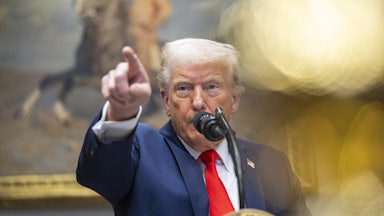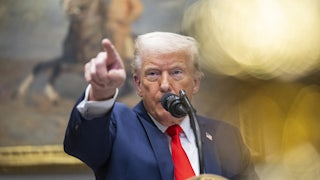“No climate, no deal” is the new catchphrase among climate groups and lawmakers in the House and Senate. Not just stalwart Green New Dealers like Massachusetts Senator Ed Markey but also more centrist types like Senator Michael Bennet of Colorado and New Mexico Senator Martin Heinrich have echoed the sentiment with tweets and press statements in the past few days. So far, nine senators and 12 House members have said they won’t vote for any version of the White House’s infrastructure bill that doesn’t include bold climate action. But what exactly does “bold” mean?
For now, that’s not clear.
Climate-focused Democrats frustrated with the amount of time being spent on bipartisan negotiations have been slow to articulate a concrete counteroffer to the current $1 trillion proposal, only $579 billion of which is new spending, set to be dispersed over eight years. “The next step is to give those demands some teeth,” said Kaniela Ing, climate justice campaign director at People’s Action, referring to the “no climate, no deal” rhetoric. But so far “there have been no hard agreements,” he said, among those unhappy with what’s on the table. Progressive offices and nonprofits are now in the process of trying to align their priorities, which may include $1 trillion of funding for public renewables and $500 billion for clean transportation. The Congressional Progressive Caucus (CPC) has put out several climate priorities for an infrastructure package, including investment in renewables and energy efficiency. Any forthcoming proposal is likely to incorporate pieces from various bills introduced by more left-leaning party members that appear in the CPC’s list, including an environmental justice mapping initiative, a Civilian Conservation Corps, and a clean electricity standard.
Climate advocates are broadly skeptical about bipartisan infrastructure talks. One tactic they do seem to agree on, Sunrise Movement Legislative Director Lauren Maunus told me by phone, is withholding votes as leverage to make sure a budget resolution can pass that creates a path toward a bolder reconciliation package. Senate Majority Leader Chuck Schumer is pushing a two-track approach: one smaller and entirely paid-for bipartisan package and a broader reconciliation measure passed along party lines. The White House has reportedly given the Senate gang seven to 10 days to finalize the former. On the latter, Schumer—who has vowed “bold” action on climate—has said he’ll push for clean energy tax credits and electric vehicle rebates to be included in the leadership’s “Unity Budget.”
Others have more aggressively demanded an end to bipartisan talks. “We cannot let Republican calls for bipartisanship deny the American people the climate action they have been demanding,” Markey said in a press conference Tuesday, comparing GOP negotiating tactics to the ones deployed a decade ago to stop his cap-and-trade package: “Dither, delay, deny.” Elizabeth Warren told Politico, “It has to be one bill, not two.” Splitting the difference, Senator Jeff Merkley said he hoped for “two tracks welded together,” which put climate at the center. As of writing, there aren’t enough Democratic votes to get the still-unreleased $1 trillion bipartisan package through.
The prospect of moving past the current stalemate sometime soon is good news for climate measures that seemed destined to be cut just a few days ago. Yet it will take a lot to balance out the carbon footprint of an infrastructure package geared toward roads and bridges that involve lots of carbon-intensive steel and concrete. And making a dent in preexisting U.S. carbon emissions is an even bigger task. The Biden administration’s most ambitious original articulation of climate policy in the American Jobs Plan and American Families Plan included only modest spending on green priorities, many of them funneled through tax credits aimed at coaxing forth private investment in things like transmission lines and electric charging stations. Climate groups that backed Bernie Sanders and Warren in the primaries are now trying to make sure Biden’s already limited proposals aren’t whittled down further.
“We understand the political constraints and reality in this moment, and we need to work within them while continuing to shift the conditions for more ambitious climate action in years to come,” Maunus said. “We need to make sure that Biden does not walk back his campaign commitments and the American Jobs Plan. That’s already a compromise, and we can’t afford anything less than that.”
There are hard limits to how much any infrastructure plan can do for the planet. Spending can catalyze markets for electric vehicles and renewable energy, but that is a far cry from the kind of regulations needed to set firm targets to reduce greenhouse gas emissions. As with the Obama administration’s Clean Power Plan, any attempt actually to use the Environmental Protection Agency’s carbon-constraining authority is likely to face intense challenges from courts stacked with Federalist Society acolytes.
Climate envoy Gina McCarthy has also been trying to dampen expectations about whether an eventual infrastructure deal would include a clean electricity standard. Many environmental groups have been pinning their hopes on that policy, which aims to green the power sector by incentivizing lower-carbon generation to achieve 80 percent clean energy by 2030. The think tank Evergreen Action argues that it could pass through reconciliation by being structured as a spending measure. That said, not all clean energy standards are created equal. Those pushing for one urge caution in sorting out the details. “A clean energy standard that puts more incentives toward workarounds for continuing on with fossil fuels—like a ton of [carbon capture and storage] and gas, rather than prioritizing renewables—seems unsatisfactory,” Maunus told me.
Much like the earth’s life support systems, infrastructure talks could still collapse. Republicans are hoping that some Democrats’ two-track wager, for a funded physical infrastructure plan and then a base-pleasing reconciliation measure, fails. As Senate Minority Whip John Thune told Politico, “The stars are kind of lining up for an infrastructure bill. And if you do do something bipartisan on that, then I think doing something partisan on reconciliation—in some ways, with certain Democrats—it gets a lot harder.”
The GOP doesn’t have much incentive to back any infrastructure package. With fewer competitive House districts than ever before, Republicans’ reelections depend on a shrinking core of increasingly radicalized voters. Blocking a popular spending package increases the already decent chances for them to win back the House in 2022, by leaving Democrats with less to show voters. Mitch McConnell has similarly signaled that a GOP-controlled Senate would block a Biden Supreme Court nomination. And it seems unlikely that a majority of Republicans would vote to certify a legitimate presidential election, either.
Accordingly, with midterm elections fast approaching, this infrastructure package may well be the last chance Democrats have to pass climate policy for at least a decade. By the time they get another go, at some point in the 2030s, global temperatures could have already warmed by 1.5 degrees Celsius (2.7 degrees Fahrenheit) above preindustrial levels.
If Democrats can’t come together to pass even this, prospects for more comprehensive policies are grim indeed. Far off as it seems now, decarbonizing the United States is a relatively small piece of slowing warming. As the world’s largest oil exporter and one of its top gas exporters, the U.S. could continue to export prodigious amounts of fossil fuels to be burned across the world for decades to come, even under the most robust form of Biden’s American Jobs Program—especially if oil stays on track to reach $100 a barrel. As Obama administration alum Andrew Light noted at his recent confirmation hearing to become the Department of Energy’s assistant secretary for international affairs, “My job in this role is to make sure U.S. gas is competitive around the world.” Low- and middle-income countries will need serious injections of cash to leapfrog over fossil energy and keep from locking in dirty infrastructure for decades to come. Congress doesn’t seem likely to authorize that kind of spending.
So far, the administration has been weary of framing the climate challenge as anything other than a win-win for polluters and the planet, even pitching its infrastructure plans to the likes of the American Petroleum Institute. Despite recent recommendations from the International Energy Agency to halt new oil and gas development and rapidly scale down liquefied natural gas to keep temperatures from rising above 1.5 degrees Celsius, policies that place direct constraints on fossil fuels remain a third rail across the aisle.
The gap between the current best-case scenario for an infrastructure package and what’s needed to tackle the climate crisis is enormous, leaving political and atmospheric realities running on two separate tracks. Driving frustrations among greens is just how hard it is to pass even the lowest-hanging fruit of climate policy amid opposition from both Republicans and moderate Democrats. Progressives hoping for a better outcome expect to hold demonstrations in D.C. in the weeks to come to ramp up pressure on infrastructure talks, building on a spate of in-district actions during recent congressional recesses. Whether it’s enough to unlock a more hopeful path forward for U.S. climate policy remains to be seen.








